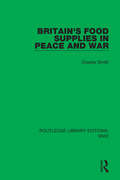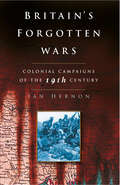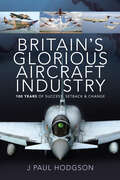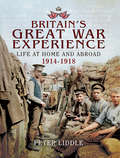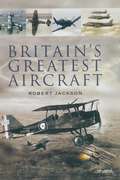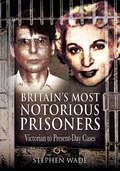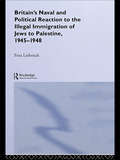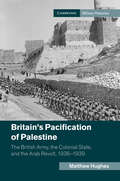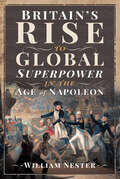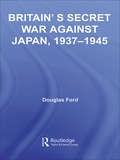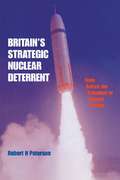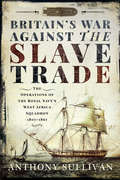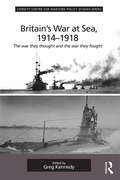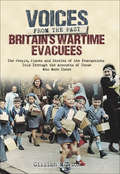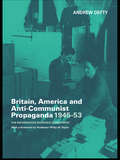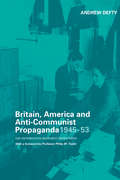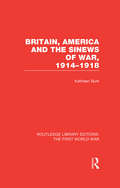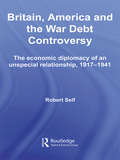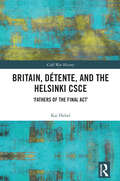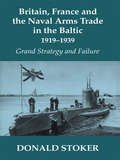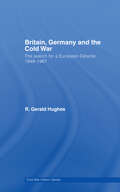- Table View
- List View
Britain's Food Supplies in Peace and War (Routledge Library Editions: WW2 #3)
by Charles SmithThis book, first published in 1940, is a systematic analysis of Britain’s principal food supplies and the means by which they are distributed to the people. Its calculates the total quantities of food required to feed the whole nation properly, examines pricing structures and the sources of the food stuffs. Both home produced and imported foods are covered in this survey, as are restrictions in the form of the wartime governmental controls.
Britain's Forgotten Wars: Colonial Campaigns of the 19th Century
by Ian HernonThis is a collection of Ian Heron's three books, "Massacre and Retribution", "The Savage Empire" and "Blood in the Sand". Much has been written about the great British military triumphs of the 19th century, but there are many more astonishing stories which have been largely forgotten. These forgotten wars cannot hope to compete in history with the Crimean War or the Boer War, but for acts of sheer courage and endurance, they deserve to be remembered. Using the actual words of the soldiers themselves, Ian Hernon presents an account which evokes Victorian colonial warfare in all its barbarity and the self-righteous belief of the British in the rectitude of their cause.
Britain's Glorious Aircraft Industry: 100 Years of Success, Setback & Change
by J Paul Hodgson“The rich and diverse history of the British aircraft industry is captured in superb detail by the author in this weighty tome.” —Aviation NewsGreat Britain’s aircraft industry started in 1908, with the first formally registered organization in the world to offer to design and build an aeroplane “for commercial gain.” This book tells the complete story of the 110 years since the start, all the companies formed and the aircraft they produced, highlighting the advances in aeronautical ambition and technology. It is the story of the creation, survival and decline of all one hundred and twenty-three of the aircraft design and construction companies formed between 1908 and 2018. The exhilaration of success and the magic of aviation technology are vividly illustrated by the technical and political birth stories of iconic projects, such as the Cirrus/Gypsy Moths, the Tiger Moth, the flying boats of Imperial Airways, Spitfire, Lancaster, Viscount, Vulcan, Harrier, Buccaneer and many more.The rotary wing industry is not forgotten. The birth of the jet turbine engine and the quest for supersonic speed is included. The stories of the disappointments of failure and disaster, such as the Brabazon, Comet, Princess, Rotodyne and TSR-2, and the growth of international collaboration in Concorde, Tornado, Airbus, Eurofighter Typhoon and other projects are included, in the context of the international scene and domestic politics. The conclusion highlights the prominent reminiscences and speculates on the future of the aircraft industry in Britain.“An outstanding reference book and a thoroughly enjoyable canter through the decades, from the days of wood and fabric to the modern composite structure of the wings of the A400 Atlas.” —RAF Historical Society
Britain's Great War Experience: Life at Home and Abroad, 1914–1918
by Peter LiddleExpertly written and beautifully presented, this book of outstanding photographs, documents and art work captures the spirit of the British people as they faced and successfully came through the prolonged challenge of the First World War. Using previously unpublished material from the Liddle Collection in the University Library at Leeds and supporting this with photographs from private and public collections from many parts of the British Isles, Britons Experience the Great War brings the experience of soldiers, sailors and airmen graphically close. It is, however, not just the fighting fronts which are so well represented: from the industrial, agricultural, domestic, educational and war resistance scenes, the response to war of workers, wives, sweethearts, students, children, rebels and resisters is made clear. Fund raising, rationing, humour, anxiety and grief are documented in this book in a way which provides touching testimony of the spirit of the times.With almost four hundred illustrations, the book spans the British Isles and the most remote fighting fronts.
Britain's Greatest Aircraft
by Robert JacksonDuring the last century the British aircraft industry created and produced many outstanding aeroplanes. These aircraft were world leaders in advanced technology, utilizing inventions by British engineers and scientists such as radar, the jet engine, the ejector seat and vertical take-off and landing. This book describes the design-history, development and operational careers of twenty-two legendary military and civil aeroplanes. Each one has played a significant part in aviation history.Sopwith Camel, SE.5, Bristol F2B Fighter and the Airco DH4 were all great successes in the relatively early days of flight. In the thirties the Bristol Bulldog fighter was an outstanding export success and the Short 'C' Class flying boat, later to become the Sunderland of World War II fame, pioneered the long-distance routes to the Empire. The pugnacious foreign policy of Hitler's Reich rung sudden alarm bells, rapid advances in fighting aircraft for the RAF became a premium objective. The brilliant Geodic construction of the Vickers Wellington bomber helped it survive terrible punishment throughout World War II, both the Hawker Hurricane and the Supermarine Spitfire saved England from invasion and the Bristol Beaufighter, de Havilland Mosquito and Avro Lancaster took the war to enemy soil. The Gloster Meteor became the word's first operational jet fighter and the English Electric Canberra became the RAF's first jet bomber and was manufactured under licence in the USA as the Martin B-57. In post-war years the Vickers Viscount became the world's first turboprop airliner and eventually became Britain's best selling commercial aircraft, whilst the de Havilland Comet became the world's first jet airliner. Despite Britain's recessionary years in the 50s and early 60s, military success came with the beautiful Hawker Hunter, the super-sonic Fairey Delta experimental aircraft that broke the World Air Speed Record and the Vickers Valiant that pioneered the operational techniques to deliver Britain's nuclear deterrent. Later, there followed the Mach 2 English Electric Lightning and the ill-fated TSR-2, the cancellation of which is still regarded as one of the greatest mistakes ever made in British aviation history. Finally, the Harrier, the world's first vertical take-off and landing jet fighter that is still in service and now only being built in the USA.Finally the Harrier, the world's first vertical take-off and landing jet fighter, still in service and now being further developed in the USA.
Britain's Island Fortresses: Defence of the Empire 1756–1956
by Bill ClementsA study of how the Royal Navy defended the British Empire&’s far-flung bases, from Bermuda to Hong Kong and beyond. Includes maps and photos. During the nineteenth century, the Royal Navy played a key role in defending the expanding British Empire. As sail gave way to steam power, there was a pressing requirement for coaling stations and dock facilities across the world&’s oceans. These strategic bases needed fixed defenses. In Britain&’s Island Fortresses, historian Bill Clements describes in detail, with the aid of historic photographs, maps and plans, the defenses of the most important islands, Bermuda, Ceylon, Hong Kong, Jamaica and Singapore, and a number of lesser ones including Antigua, Ascension, Mauritius, St. Helena, and St. Lucia. He describes how the defenses were modified over the years in order to meet the changing strategic needs of the Empire, and the technological changes brought about by the Industrial Revolution. Only three of these bases had to defend themselves in war—Hong Kong, Singapore and Ceylon—and the author relates the battles for these bases. This is a fascinating read for anyone interested in the maritime history of the British Empire.
Britain's Last Tommies: Final Memories from Soldiers of the 1914–18 War—In Their Own Words
by Richard van EmdenIn the later 2nd century BC, after a period of rapid expansion and conquest, the Roman Republic found itself in crisis. In North Africa her armies were already bogged down in a long difficult guerrilla war in a harsh environment when invasion by a coalition of Germanic tribes, the Cimbri, Teutones and Ambrones, threatened Italy and Rome itself, inflicting painful defeats on Roman forces in pitched battle Gaius Marius was the man of the hour. The first war he brought to an end through tactical brilliance, bringing the Numidian King Jugurtha back in chains. Before his ship even returned to Italy, the senate elected Marius to lead the war against the northern invaders. Reorganizing and reinvigorating the demoralized Roman legions, he led them to two remarkable victories in the space of months, crushing the Teutones and Ambrones at Aquiae Sextae and the Cimbri at Vercellae. The Roman army emerged from this period of crisis a much leaner and more professional force and the author examines the extent to which the 'Marian Reforms' were responsible for this and the extent to which they can be attributed to Marius himself.
Britain's Most Notorious Prisoners: Victorian to Present-Day Cases
by Stephen WadeFrom Oscar Wilde to the Kray brothers—a unique history of the lives and crimes of the United Kingdom&’s most famous, and infamous, inmates. Their names can chill the blood of true-crime aficionados: Peter Sutcliffe, aka The Yorkshire Ripper; child-torturer Ian Brady; cannibal Dennis Nilsen; serial killer Beverley Allitt. Some are tinged in glamour: beautiful nightclub hostess Ruth Ellis, hanged for a crime of passion. While others hold a bizarre fascination, like bare-knuckle boxer Michael Gordon Peterson. Called &“the most violent prisoner in Britain&” he changed his name to Charles Bronson in honor of the Death Wish star. Only to change it yet again to Charles Salvador, in honor of his favorite artist, Dali. By any name, the &“one-man riot&” was a prison superstar. Britain&’s Most Notorious Prisoners tells the stories of these lives and many more inside the Big House where prison culture breeds a strange, unreal community. It&’s also where the system learns to cope with those who refuse to live by the law of the land: killers and rapists, spies, gangster, hit-men, political prisoners, and serial offenders—as well as some who were egregiously wronged. From headline-makers to long-forgotten villains, these stories make for a thrilling and harrowing look at life, death, and survival behind bars.
Britain's Naval and Political Reaction to the Illegal Immigration of Jews to Palestine, 1945-1949
by Freddy LiebreichThis book provides an important shift in the analysis of Britain's policy towards the illegal postwar Jewish immigration into Palestine. It charts the development of Britain's response to Zionist immigration, from the initial sympathy, as embodied in the Balfour Declaration, through attempts at blockade, refoulement and finally disengagement.The book exposes differences in policy pursued by the great departments of state like the Foreign, Colonial and War Offices and their legal advisors, and those implemented by the Admiralty. The book argues that the eventual failure of Britain's immigration policy was inevitable in view of the hostility shown by many European nations, and America, towards Britain's ambition to retain her position in the Middle East.
Britain's Pacification of Palestine: The British Army, the Colonial State, and the Arab Revolt, 1936–1939 (Cambridge Military Histories)
by Matthew HughesIn this complete military history of Britain's pacification of the Arab revolt in Palestine, Matthew Hughes shows how the British Army was so devastatingly effective against colonial rebellion. The Army had a long tradition of pacification to draw upon to support operations, underpinned by the creation of an emergency colonial state in Palestine. After conquering Palestine in 1917, the British established a civil Government that ruled by proclamation and, without any local legislature, the colonial authorities codified in law norms of collective punishment that the Army used in 1936. The Army used 'lawfare', emergency legislation enabled by the colonial state, to grind out the rebellion. Soldiers with support from the RAF launched kinetic operations to search and destroy rebel bands, alongside which the villagers on whom the rebels depended were subjected to curfews, fines, detention, punitive searches, demolitions and reprisals. Rebels were disorganised and unable to withstand the power of such pacification measures.
Britain's Railways in the First World War
by Michael FoleyIt is easy to believe that the only part that Britain’s railways played in the First World War was to carry the soldiers to the ships that would take them to France. This couldn’t be further from the truth. Without the help from the railways it is unlikely that the war would have been over as quickly as it was. In Britain’s Railways in the First World War Michael Foley examines how the railway system and its workers proved to be a vital part of the war effort, one contemporary writer even commenting that he thought they were as significant as the navy. The book describes how the enlistment of railway troops for the Royal Engineers to meet the increasing transport demands of the military was to bleed the civilian system dry as skilled railwaymen were sent to work at the front. In addition, the military commandeered thousands of Britain’s railway vehicles, sending them to each of the theatres of war, and turned the already stressed railway workshops away from maintaining what remained of the country’s railways and rolling stock so they could produce armaments for the forces instead. The book also reveals how the British were so far behind their enemies and allies in the use of railway support to the front lines that they had to plead for help from Canada.
Britain's Rise to Global Superpower in the Age of Napoleon
by William NesterThe first study to explore all Britain’s key land and sea campaigns from 179–1815 and the two military geniuses who vanquished France. The art of power consists of getting what one wants. That is never more challenging than when a nation is at war. Britain fought a nearly nonstop war against first revolutionary then Napoleonic France from 1793 to 1815. During those twenty-two years, the government formed, financed, and led seven coalitions against France. The French inflicted humiliating defeats on the first five. Eventually Britain and its allies prevailed, not once but twice, by vanquishing Napoleon temporarily in 1814 and definitively in 1815.French revolutionaries had created a new form of warfare, which Napoleon perfected. Never before had a government mobilized so much of a realm’s manpower, industry, finance, and patriotism, nor, under Napoleon, wielded it more effectively and ruthlessly to pulverize and conquer one’s enemies.Britain struggled up a blood-soaked learning curve to master this new form of warfare. With time the British made the most of their natural strategic and economic advantages. Britons were relatively secure and prosperous in their island realm. British merchants, manufacturers, and financiers dominated global markets. The Royal Navy not only ruled the waves that lapped against the nation’s shores but those plowed by international commerce around the world. Yet even with those assets victory was not inevitable. Two military geniuses are the most vital reasons why Britain and its allies vanquished France when and how they did. General Arthur Wellesley, the Duke of Wellington and Admiral Horatio Nelson respectively mastered warfare on land and at sea.Of the hundreds of books on the era, none before has explored all of Britain’s land and sea campaigns from the first in 1793 to the last in 1815. This vividly written, meticulously researched book lets readers experience each level of war from the debates over grand strategy in London to the horrors of combat engulfing soldiers and sailors in distant lands and seas. Haunting voices of participants echo from two centuries ago, culled from speeches, diaries, and letters. Britain's Rise to Global Superpower in the Age of Napoleon reveals how decisively or disastrously the British army and navy wielded the art of military power during the Age of Revolution and Napoleon.
Britain's Secret War against Japan, 1937-1945 (Studies in Intelligence)
by Douglas FordA new look at how Britain’s defence establishment learned to engage Japan’s armed forces as the Pacific War progressed. Douglas Ford reveals that, prior to Japan’s invasion of Southeast Asia in December 1941, the British held a contemptuous view of Japanese military prowess. He shows that the situation was not helped by the high level of secrecy which surrounded Japan’s war planning, as well as the absence of prior engagements with the Imperial Japanese Navy and Army. The fall of ‘Fortress Singapore’ in February 1942 dispelled the notion that the Japanese were incapable of challenging the West. British military officials acknowledged how their forces in the Far East were inadequate, and made a concerted effort to improve their strength and efficiency. However, because Britain’s forces were tied down in their operations in Europe, North Africa and the Mediterranean, they had to fight the Japanese with limited resources. Drawing upon the lessons obtained through Allied experiences in the Pacific theatres as well as their own encounters in Southeast Asia, the British used the available intelligence on the strategy, tactics and morale of Japan’s armed forces to make the best use of what they had, and by the closing stages of the war in 1944 to 1945, they were able to devise a war plan which paved the way for the successful war effort. This book will be of great interest to all students of the Second World War, intelligence studies, British military history and strategic studies in general.
Britain's Strategic Nuclear Deterrent: From Before the V-Bomber to Beyond Trident
by Robert H. PatersonHaving served opposite Warsaw Pact forces in the 1950s and on Embassy duty in the 70s in Europe, the author offers a reasoned assessment of Britain's role in the so-called "nuclear club". He asks whether Britain really needs to be a member.
Britain's Two World Wars Against Germany
by Brian BondBritain's role and performance in the two World Wars continues to generate considerable debate but the wars are rarely considered together. Leading military historian Brian Bond here challenges the popular view of the First World War as catastrophic and futile in contrast to the Second World War as a well-conducted and victorious moral crusade. He focuses on the key issues which have caused controversy and distortion, to demonstrate how these views became deeply rooted in popular culture in the years since 1945. These issues range from policy and strategy, combat experience, the attritional strategies of naval blockade and strategic bombing to British generalship, and gains and losses in the aftermath of both wars. He also considers the learning process of the British Army in both world wars. He boldly concludes that in a number of important respects Britain was more successful in the First World War than in the Second.
Britain's War Against the Slave Trade: The Operations of the Royal Navy's West Africa Squadron 1807–1867
by Anthony SullivanThe true story of the Royal Navy’s sixty-year campaign to stop slavery across the British Empire, decades before the American Civil War.Long before recorded history, men, women and children had been seized by conquering tribes and nations to be employed or traded as slaves. Greeks, Romans, Vikings, and Arabs were among the earliest of many peoples involved in the slave trade, and across Africa the buying and selling of slaves was widespread. There was, at the time, nothing unusual in Britain’s somewhat belated entry into the slave trade, transporting natives from Africa’s west coast to the plantations of the New World. What was unusual was Britain’s decision, in 1807, to ban the slave trade throughout the British Empire. Britain later persuaded other countries to follow suit, but this did not stop this lucrative business. So the Royal Navy went to war against the slavers, in due course establishing the West Africa Squadron, which was based at Freetown in Sierra Leone. This force grew throughout the nineteenth century until a sixth of the Royal Navy’s ships and marines was employed in the battle against the slave trade. Between 1808 and 1860, the West Africa Squadron captured 1,600 slave ships and freed 150,000 Africans. In Britain’s War Against the Slave Trade, naval historian Anthony Sullivan reveals the story behind this little-known campaign. Whereas Britain is usually, and justifiably, condemned for its earlier involvement in the slave trade, the truth is that in time the Royal Navy undertook a major and expensive operation to end what was, and is, an evil business.
Britain's War At Sea, 1914-1918: The war they thought and the war they fought (Corbett Centre for Maritime Policy Studies Series)
by Greg KennedyIn Britain, memory of the First World War remains dominated by the trench warfare of the Western Front. Yet, in 1914 when the country declared war, the overwhelming expectation was that Britain’s efforts would be primarily focussed on the sea. As such, this volume is a welcome corrective to what is arguably an historical neglect of the naval aspect of the Great War. As well as reassessing Britain’s war at sea between 1914 and 1918, underlining the oft neglected contribution of the blockade of the Central Powers to the ending of the war, the book also offers a case study in ideas about military planning for ’the next war’. Questions about how next wars are thought about, planned for and conceptualised, and then how reality actually influences that thinking, have long been - and remain - key concerns for governments and military strategists. The essays in this volume show what ’realities’ there are to think about and how significant or not the change from pre-war to war was. This is important not only for historians trying to understand events in the past, but also has lessons for contemporary strategic thinkers who are responsible for planning and preparing for possible future conflict. Britain’s pre-war naval planning provides a perfect example of just how complex and uncertain that process is. Building upon and advancing recent scholarship concerning the role of the navy in the First World War, this collection brings to full light the dominance of the maritime environment, for Britain, in that war and the lessons that has for historians and military planners.
Britain's Wartime Evacuees: The People, Places and Stories of the Evacuations Told Through the Accounts of Those Who Were There (Voices from the Past)
by Gillian MawsonWith the declaration of war in September 1939, the Government Evacuation Scheme was implemented, in which almost one and a half million civilians, mostly children, were evacuated from the British cities thought most likely to be the targets of aerial bombing. The fear of invasion the following year resulted in another mass evacuation from the coastal towns.Hundreds of thousands of school children, and mothers with babies and infants, were removed from their homes and families, and sent to live with strangers in distant rural areas and to entirely unfamiliar environments. Some children were also sent to countries of the Commonwealth, such as Canada and Australia. The evacuations had an enormous impact upon millions of individuals, both those that were evacuated and those that had to accommodate and care for the displaced multitude.Over the course of eight years research Gillian Mawson has interviewed hundreds of evacuees from England, Northern Ireland, Scotland and Wales. Families have also allowed her access to the testimony of those who have passed away. Coupled with the extensive newspaper coverage of the day and official documents Britains Wartime Evacuees provides not just a comprehensive study of the evacuations, but also relates some of the most moving and emotive stories of the Second World War.
Britain, America and Anti-Communist Propaganda 1945-53: The Information Research Department (Studies in Intelligence)
by Andrew DeftyIn the Cold War battle for hearts and minds Britain was the first country to formulate a coordinated global response to communist propaganda. In January 1948, the British government launched a new propaganda policy designed to 'oppose the inroads of communism' by taking the offensive against it.' A small section in the Foreign Office, the innocuously titled Information Research Department (IRD), was established to collate information on communist policy, tactics and propaganda, and coordinate the discreet dissemination of counter-propaganda to opinion formers at home and abroad.
Britain, America and Anti-Communist Propaganda 1945-53: The Information Research Department (Studies in Intelligence)
by Andrew DeftyIn the Cold War battle for hearts and minds Britain was the first country to formulate a coordinated global response to communist propaganda. In January 1948, the British government launched a new propaganda policy designed to 'oppose the inroads of communism' by taking the offensive against it.' A small section in the Foreign Office, the innocuously titled Information Research Department (IRD), was established to collate information on communist policy, tactics and propaganda, and coordinate the discreet dissemination of counter-propaganda to opinion formers at home and abroad.
Britain, America and the Sinews of War 1914-1918 (Routledge Library Editions: The First World War)
by Kathleen BurkAnglo-American relations were transformed during the First World War. Britain was already in long-term economic decline relative to the United States, but this decline was accelerated by the war, which was militarily a victory for Britain, but economically a catastrophe. This book sets out the economic, and in particular, the financial relations between the two powers during the war, setting it in the context of the more familiar political and diplomatic relationship. Particular attention is paid to the British war missions sent out to the USA, which were the agents for much of the financial and economic negotiation, and which are rescued here from underserved historical obscurity.
Britain, America and the War Debt Controversy: The Economic Diplomacy of an Unspecial Relationship, 1917-45 (British Politics and Society)
by Robert SelfThis volume throws important new light upon a pivotal period of transition in the Anglo-American relationship and sets the stage for its equally dramatic transformation during and after the Second World War. Based upon extensive research in previously unpublished archival material on both sides of the Atlantic, for the first time this book offers a detailed and comprehensive analysis of the war debt problem from its origins at the end of the First World War until its final removal with the launch of Roosevelt's Lend-Lease programme in 1940-41. This work will be of great interest to diplomats and journalists, as well as to students and scholars of political, diplomatic, economic and international history.
Britain, Détente, and the Helsinki CSCE: 'Fathers of the Final Act’ (Cold War History)
by Kai HebelThis book offers the first in-depth account of the United Kingdom’s contribution to the rapprochement between East and West that culminated in the successful negotiation of the Helsinki Final Act of 1975.Britain’s role in this historic achievement has been understudied and understated. This book rectifies this shortcoming by tracing London’s important contribution to East-West diplomacy with a special focus on the negotiations of the Helsinki Final Act (1972–75). The Final Act was the product of almost three years of intense bargaining in the context of the Conference on Security and Cooperation in Europe. Along with 34 other states, the UK negotiated core aspects of European international relations, including the political, territorial, and normative order of the divided continent. Taking full advantage of its new role as a member of the European Community and its traditional part in NATO, British negotiators skillfully navigated the opportunities and pitfalls of multilateral diplomacy. Their success in hammering out several of the most contested and most innovative provisions of the Helsinki Accord earned them the moniker of ‘Fathers of the Final Act’. Based on extensive archival research in eleven countries on three continents, this book traces the evolution of the negotiations, providing a compelling bottom-up account of how diplomacy works in practice against the backdrop of inter-state conflict and unequal power.This book will be of much interest to students of Cold War History, European history, British history, and International Relations.
Britain, France and the Naval Arms Trade in the Baltic, 1919 -1939: Grand Strategy and Failure (Cass Series: Naval Policy and History #Vol. 18)
by Donald StokerThe strategy of the British and French prior to World War II was to preserve the status quo after the disaster of World War I. Donald Stoker's book examines British and French involvement from 1919 to 1939 in the creation and development of the naval forces of Poland, Finland and the three Baltic states of Estonia, Latvia and Lithuania. This is an in-depth scholarly study of a subject that should appeal to students of international history, strategy, international relations and naval history in general.
Britain, Germany and the Cold War: The Search for a European Détente 1949–1967 (Cold War History)
by R. Gerald HughesThis well-researched book details the ambiguity in British policy towards Europe in the Cold War as it sought to pursue détente with the Soviet Union whilst upholding its commitments to its NATO allies. From the early 1950s, Britain pursued a dual policy of strengthening the West whilst seeking détente with the Soviet Union. British statesmen realized that only through compromise with Moscow over the German question could the elusive East-West be achieved. Against this, the West German hard line towards the East (endorsed by the United States) was seen by the British as perpetuating tension between the two blocs. This cast British policy onto an insoluble dilemma, as it was caught between its alliance obligations to the West German state and its search for compromise with the Soviet bloc. Charting Britain's attempts to reconcile this contradiction, this book argues that Britain successfully adapted to the new realities and made hitherto unknown contributions towards détente in the early 1960s, whilst drawing towards Western Europe and applying for membership of the EEC in 1961. Drawing on unpublished US and UK archives, Britain, Germany and the Cold War casts new light on the Cold War, the history of détente and the evolution of European integration. This book will appeal to students of Cold War history, British foreign policy, German politics, and international history.
